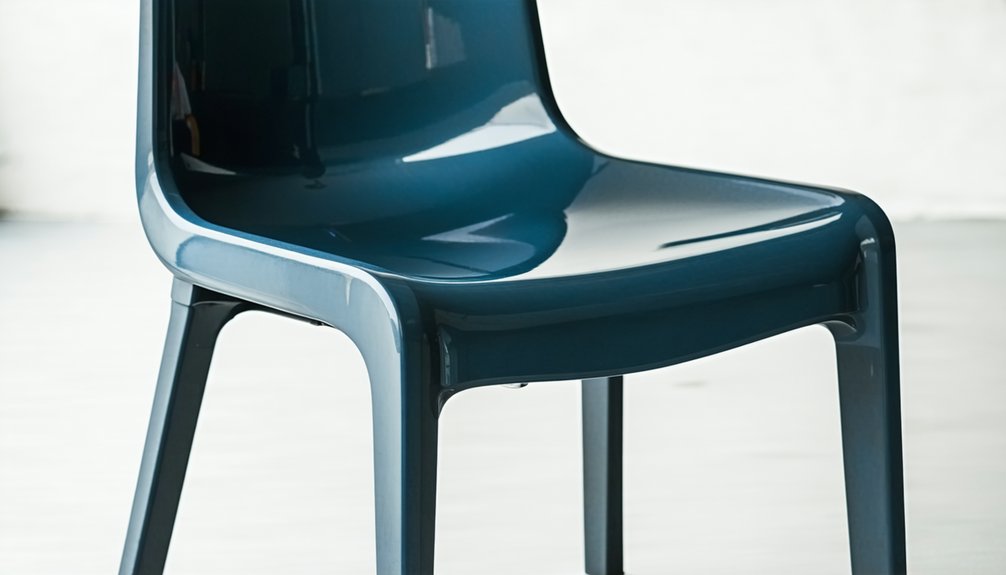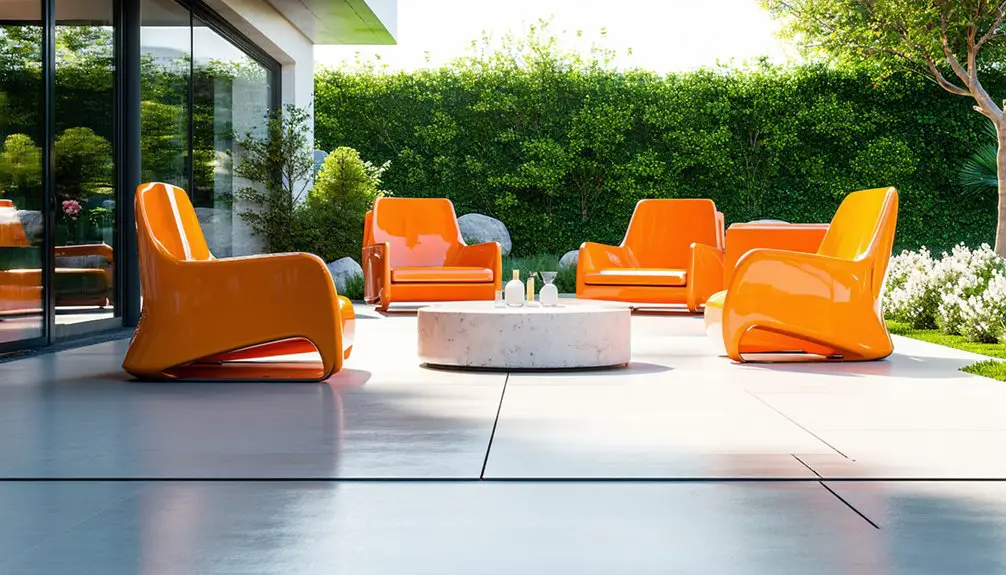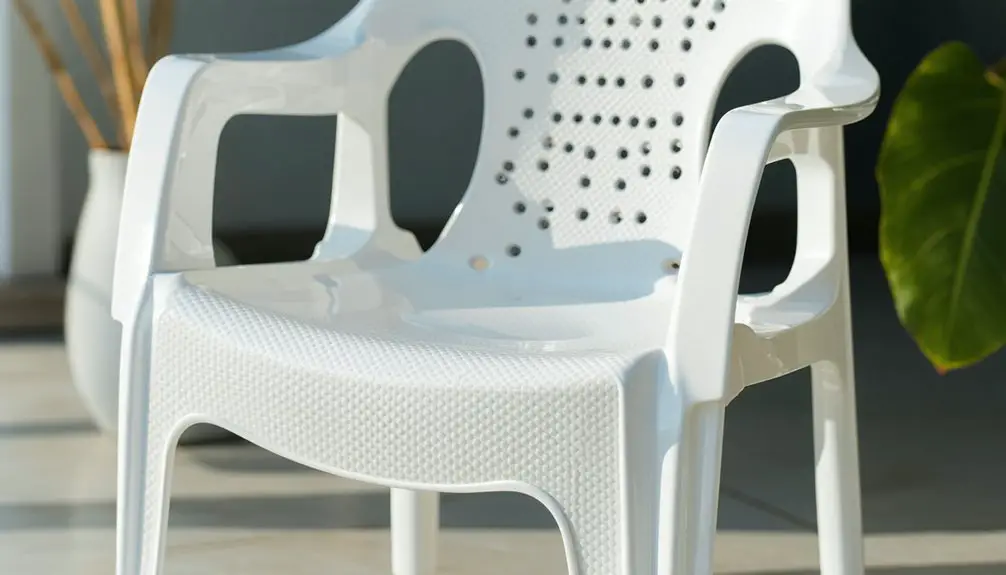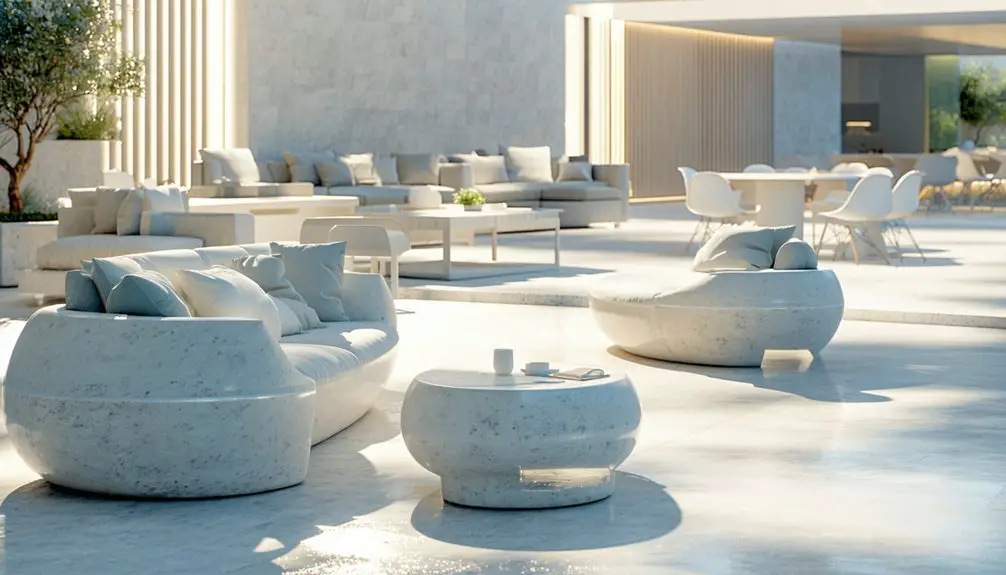When you're looking for well-made plastic furniture, start by checking the material composition. High-density polyethylene (HDPE) is a strong indicator of quality and durability. Pay attention to reinforced joints and high scratch resistance, as these features suggest superior construction. A smooth surface finish and UV stabilization will help prevent fading over time. Additionally, reputable brands often provide solid warranties, reflecting their confidence in the product's longevity. Lastly, consider both the price and long-term value; investing a bit more typically means better quality. Want to explore more signs of quality plastic furniture? There's plenty to uncover!
Key Takeaways
- High-quality materials like HDPE and polypropylene ensure durability, UV resistance, and weatherproofing for outdoor applications.
- Reinforced joints and frames enhance structural integrity, contributing to the overall stability and longevity of the furniture.
- Scratch and impact resistance indicate robust surface quality, essential for maintaining appearance and function over time.
- Stainless steel hardware resists corrosion, ensuring stability and reliability in various environmental conditions.
- A reputable brand with solid warranty coverage reflects commitment to quality and customer support, enhancing long-term value.
Material Composition
When choosing plastic furniture, understanding its material composition is crucial for making an informed decision.
You'll come across several types of plastics, each with unique properties that affect durability and usability.
Polypropylene (PP) is popular for its high stiffness and strength, making it great for chairs. It's lightweight, easy to clean, and can handle extreme temperatures. Plus, it's recyclable, so you're making an eco-friendly choice. Additionally, polypropylene is known for its high chemical resistance, ensuring longevity in various environments.
Acrylonitrile Butadiene Styrene (ABS) is another excellent option, known for its strength and impact resistance. It's perfect for heavy loads, making it suitable for commercial settings like restaurants. Its easy maintenance adds to its practicality.
If you prefer something lightweight and transparent, consider Polycarbonate (PC). It boasts exceptional strength and impact resistance, with a natural UV filter for outdoor use. However, be cautious, as it can scratch easily.
Lastly, High-Density Polyethylene (HDPE) is robust and reliable, often found in outdoor furniture. Its superior chemical resistance and flexibility make it ideal for various applications.
Build and Construction
Understanding the build and construction of plastic furniture is essential for ensuring you choose pieces that are both durable and reliable.
Look for furniture made through injection molding or rotational molding, as these processes enhance strength and quality. Injection molding uses sophisticated molds and precise heating, while rotational molding forms strong, hollow pieces by tumbling molds with plastic resin in an oven.
Pay attention to the hardware and fasteners used. Quality pieces often feature stainless steel hardware that resists corrosion and ensures stability in various weather conditions.
Secure fastening improves weight distribution, preventing instability in windy conditions, which is critical for safety. Additionally, many types of plastic furniture are made from recyclable materials, adding an eco-friendly aspect to your purchase.
Examine the stability and weight distribution of the furniture. A well-constructed design should resist tipping or toppling, maintaining structural integrity over time.
Some pieces may even include anchor capabilities for added security.
Lastly, consider maintenance and durability. Look for furniture that's low maintenance, requiring just a rinse with soapy water to clean.
UV-resistant materials like HDPE ensure that color vibrancy and strength are retained, making your investment last longer against harsh weather and impacts.
Finish and Surface

When assessing the finish and surface of plastic furniture, you should pay attention to the smoothness of the texture, as it affects both appearance and usability. Additionally, understanding the surface finish specifications can help you discern the quality of the furniture, as different standards like SPI and VDI provide insights into the finish types used. UV resistance measures are also important, ensuring your furniture can withstand sunlight without fading or degrading. Furthermore, HDPE durability contributes to the overall quality and lifespan of the furniture. Lastly, consistent color quality can make a significant difference in the overall aesthetic, so look for any variations that might indicate inferior manufacturing.
Smooth Surface Texture
Achieving a smooth surface texture is essential for both the functionality and aesthetic appeal of plastic furniture. When you choose high-quality materials like high-density polyethylene (HDPE) and polypropylene, you're investing in durability and resistance to weather. These materials are inherently waterproof and insect-proof, ensuring an intact surface that resists degradation. Additionally, proper care through regular maintenance can significantly enhance the longevity of your plastic furniture.
To maintain that smooth finish, regular cleaning with mild soap is key. Avoid harsh chemicals that can damage the surface. If you notice any chalky film, skip the vinegar and baking soda; instead, use dish soap and water for a proper clean.
If your furniture shows signs of wear, applying multiple light coats of clear spray paint specifically designed for plastic can restore its smooth texture. Make sure to allow intervals between coats for the best results.
Lastly, consider protective measures, such as covers, to extend the furniture's lifecycle and maintain its surface. Regular inspections for loose screws or damage will also help prevent degradation.
UV Resistance Measures
To ensure your plastic furniture stands up to the harsh effects of sunlight, incorporating UV resistance measures is crucial. High-density polyethylene (HDPE) and polypropylene are excellent choices for their durability and ability to withstand severe weather.
Polycarbonate plastic also excels in UV resistance, while olefin is known for its strength and colorfastness.
When selecting furniture, look for products that include UV-resistant additives. These additives play a vital role in preventing premature fading and cracking, ensuring your furniture retains its vibrant color and strength over time.
The use of UV stabilizers during manufacturing enhances overall durability and aesthetic appeal, making your furniture more resilient against sun exposure.
Manufacturing processes like injection and rotational molding further enhance the strength of your furniture. By incorporating UV-resistant materials during these processes, manufacturers ensure consistent protection against degradation.
Lastly, to maintain UV resistance, you should regularly clean your furniture and inspect it for loose screws. Proper material selection can optimize your outdoor furniture investments for long-term durability and performance.
Using protective covers and UV protectant sprays can extend the life of your furniture, while solution-dyed polyester or vinyl covers offer excellent protection against UV damage and moisture.
Taking these steps helps ensure your plastic furniture remains in top condition for years to come.
Consistent Color Quality
After ensuring UV resistance, the next factor to consider in quality plastic furniture is consistent color quality. A specialized coloring process plays a crucial role in achieving this. It ensures that color is evenly distributed throughout the material, preventing loss and maintaining vibrancy over time. The use of color additive masterbatch, which blends pigments with resin into small pellets, guarantees uniformity. This method not only saves time but also reduces costs associated with manual pigment addition.
Here's a quick overview of the key aspects of consistent color quality:
| Aspect | Description | Benefit |
|---|---|---|
| Specialized Coloring | Ensures constant color throughout the material | Prevents color loss |
| Color Additive Masterbatch | Blends pigments into resin for uniform color | Saves time and reduces costs |
| Consistent Saturation | Maintains color consistency without streaks | Enhances visual appeal |
| Manufacturing Precision | Ensures even application of color | Improves durability and quality |
Comfort and Ergonomics
When it comes to comfort and ergonomics in plastic furniture, thoughtful design features play a crucial role in your overall experience. You'll appreciate elements like lumbar support that ensure your lower back stays comfortable and promotes proper posture.
The seat height and depth are optimized to provide adequate legroom, making it easier for you to settle in and relax. Adjustable features are vital, too. Whether it's the seat height, backrest, or armrests, these customizable options fit your unique body shape and size.
This thoughtful design supports your spine's natural curve, preventing postural problems over time. Cushioning matters as well; high-quality memory foam cushions expand and contract to provide durability and comfort under your weight.
Breathable materials keep you cool, while rounded edges reduce pressure points, enhancing your sitting experience. You'll notice how soft mesh alternatives prevent skin abrasions, ensuring you stay comfortable even during extended use.
These design aspects not only support blood circulation and reduce discomfort but also create a floating sensation in some chairs, making your seating experience enjoyable.
Ultimately, comfort and ergonomics are essential signs of well-made plastic furniture that cater to your needs.
Brand Reputation

When you're choosing plastic furniture, researching a brand's history can reveal a lot about its reliability and values.
Look for industry recognition and awards that highlight their quality and innovation, as these accolades often indicate a trusted reputation.
Additionally, check their warranty and support options, since solid customer support reflects a brand's commitment to standing behind its products.
Researching Brand History
Researching a brand's history can reveal essential insights into its reputation and quality, especially in the realm of plastic furniture.
Take Kartell, for example. They were the first to use polycarbonate in furniture in 1999, introducing transparency through their iconic La Marie chair designed by Philippe Starck. This pioneering spirit highlights their commitment to innovation, as they continuously utilize advanced materials and technologies to create unique products.
Kartell's collaboration with renowned designers like Giotto Stoppino and Joe Colombo showcases their dedication to quality and aesthetics. These partnerships have produced timeless pieces, enhancing their product range and reputation in the industry.
Their innovative production processes, including injection molding and compression molding, ensure that each item is durable and sustainable, minimizing waste.
With a global presence, Kartell operates over 130 stores worldwide, making their products accessible to a broad audience.
Their bestsellers, like the Louis Ghost chair, have played a significant role in popularizing plastic furniture.
Industry Recognition and Awards
Recognized for their commitment to sustainability and innovation, several brands in the plastic furniture industry have earned prestigious awards that reflect their excellence.
For instance, Eastman's Molecular Recycling Facility, the largest of its kind globally, has been acknowledged by the Plastics Industry Association (PLASTICS). It processes 110,000 tons of recovered plastic annually, significantly reducing greenhouse gas emissions.
Bantam Materials UK also stands out, winning the materials award from PLASTICS for its Prevented Ocean Plastic Initiative. This initiative has created a market for discarded PET in areas with limited recycling facilities, leading to the construction of collection centers and generating nearly 2,000 jobs.
Ultra-Poly Corp's ELV Bumper Recycling Program received the end-of-life award from PLASTICS for its innovative approach to recycling bumper covers, achieving vehicle-to-vehicle circularity.
Lastly, Polycarbin was recognized with the Leadership in Sustainability Innovation Award for its closed-loop system in laboratory plastics, showcasing comprehensive environmental stewardship.
These accolades not only enhance brand reputation but also demonstrate a genuine dedication to sustainable practices, making these companies leaders in the plastic furniture landscape.
Warranty and Support Options
A strong warranty and support system plays a significant role in shaping a brand's reputation in the plastic furniture industry. When you're investing in plastic furniture, it's essential to look for warranties that last up to 10 years for normal use.
These warranties typically cover manufacturing defects, breakage, and component failure, giving you peace of mind. However, be aware that damages from abuse, misuse, or neglect aren't covered.
Make sure to read the warranty conditions. Most warranties apply only to normal residential use, and exposure to extreme heat or UV rays can void them.
Additionally, neglecting maintenance or making alterations can also jeopardize your coverage. Brands that prioritize quality often provide comprehensive warranties, indicating their confidence in their products.
Some even offer lifetime warranties on specific collections, further enhancing their reputation. You might also consider extended warranty options that cover accidental damage or go beyond the standard period.
Comparing various plans can help you find the best coverage for items like sofas and dressers. Ultimately, a solid warranty and responsive customer support reflect a brand's commitment to quality and customer satisfaction, which is crucial for your furniture investment.
Price Considerations
When considering plastic furniture, you'll find that price can vary significantly based on several factors, including quality and materials used. For instance, traditional Samsonite plastic folding chairs range from $8.95 to $19.99 each. Generally, higher-priced chairs offer better weight ratings and durability, making them a worthy investment. Premium options with advanced drop test ratings come at a higher cost, reflecting their superior materials and testing standards.
Several factors influence these price differences. Fluctuations in oil prices and the cost of PVC granules can affect production costs. Additionally, the type of plastic used plays a crucial role; chairs made from new virgin plastic tend to be stronger than those made from recycled materials.
Manufacturing costs, including labor and production processes, also contribute to the final price.
The global plastic furniture market, valued at USD 13,610 million in 2021, is expected to grow significantly due to rising demand from both residential and commercial sectors. Affordability and durability are key drivers of this demand, making it essential to balance price with quality when making your purchase.
Warranty and Guarantees

Choosing plastic furniture isn't just about price; warranty and guarantees play a significant role in your decision-making process. A robust warranty can give you peace of mind, ensuring that your investment is protected against defects in workmanship and materials.
For instance, manufacturers like Berlin Gardens and Poly Outdoor Furniture offer impressive 20-year warranties for residential use, while commercial use typically gets a 5-year coverage.
When evaluating warranties, pay attention to what's covered. Look for protections against structural failures and surface defects, which are often included.
However, be aware of exclusions—warranties often don't cover damage from misuse, neglect, or alterations made by anyone other than the manufacturer.
Claim procedures matter too. Most warranties require you to submit a written claim along with your original invoice. Some brands, like Treasure Garden, may involve your dealer for claims, so keep that in mind.
Ultimately, a good warranty not only reflects the manufacturer's confidence in their product but also safeguards your purchase.
Before finalizing your choice, make sure you understand the warranty details fully. It's your best defense against unexpected issues down the line.
Frequently Asked Questions
How Can I Identify Quality Plastic Furniture in a Store?
When you're in a store, check the materials used, feel for sturdy construction, and inspect the finish. Look for smooth surfaces, no visible seams, and ergonomic designs. Trust your instincts about comfort and quality.
Are There Specific Certifications for Eco-Friendly Plastic Furniture?
Yes, there are specific certifications for eco-friendly plastic furniture. Look for FEMB Level, BIFMA Level, Greenguard, and EU Ecolabel certifications. These ensure the furniture meets environmental and health standards, promoting sustainability and safety.
What Maintenance Is Required for High-Quality Plastic Furniture?
To maintain high-quality plastic furniture, you should clean it regularly with mild soap, avoid abrasive cleaners, rinse thoroughly, dry properly, and protect it from extreme weather. Regular upkeep prevents damage and extends its lifespan.
How Does Weather Affect the Longevity of Plastic Furniture?
Weather significantly affects your plastic furniture's longevity. Prolonged sun exposure can cause fading, while cold temperatures may lead to brittleness. Regular maintenance, like cleaning and protective coverings, helps prevent damage and extends its lifespan.
Can I Use Plastic Furniture Indoors and Outdoors Interchangeably?
Yes, you can use plastic furniture indoors and outdoors interchangeably. It's durable, low-maintenance, and versatile, fitting various décor styles. Just ensure you consider weather conditions and potential wear when moving furniture between spaces.

